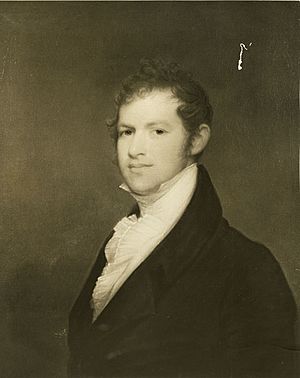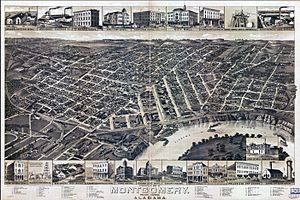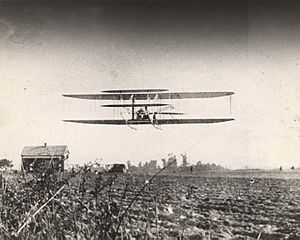History of Montgomery, Alabama facts for kids
Montgomery, Alabama, became a city in 1819. It was formed by joining two towns located along the Alabama River. In 1846, it became the capital city of Alabama. Later, in February 1861, Montgomery was chosen as the first capital of the Confederate States of America. However, the government moved to Richmond, Virginia, in May of that year. In the mid-1900s, Montgomery was a very important place for the Civil Rights Movement. Big events like the Montgomery bus boycott and the Selma to Montgomery marches happened there.
Contents
Early Settlers and Explorers
Before Europeans arrived, the Alabama River's left bank was home to the Alibamu tribe of Native Americans. The Alibamu and the Coushatta tribes, who lived across the river, were skilled at building large mounds of earth.
The first Europeans to visit central Alabama were Hernando de Soto and his group in 1540. They stayed for a week in an area called Towassa. It's also possible that Tristán de Luna y Arellano and his settlers traveled through the Montgomery area around that time.
More than a century later, in 1697, an expedition from Carolina traveled down the Alabama River. The first European to settle permanently in the Montgomery area was James McQueen. He was a Scottish trader who arrived in 1716. In 1717, the French built Fort Toulouse northeast of where Montgomery is today. This fort was mainly a trading post for trading with the Alibamu tribe.
After the French and Indian War in 1764, the British took control of the lands east of the Mississippi River that used to belong to France and Spain. In 1767, the Alabama area was split between an Indian Reserve and British West Florida. The border line was just north of present-day Montgomery. The northern part later became part of Georgia.
The Treaty of Paris in 1783 ended the American Revolutionary War. This treaty gave Georgia's territory to the United States. The southern border of this land was argued over by Spain and the United States until 1795. That's when the Treaty of San Lorenzo gave the land north of the 31st parallel to the United States. This area, including the southern half of Montgomery, became part of the Mississippi Territory in 1797. Georgia's western land was added to Mississippi in 1804.
After James McQueen, not many Europeans moved to the area right away. Abraham Mordecai from Pennsylvania arrived in 1785. He later brought the first machine for cleaning cotton, called a cotton gin, to Alabama.
The Creek War ended in August 1814. After this, the Creek tribes had to give most of their lands to the U.S. This included much of central and southern Alabama. Once the Creek groups living along the Alabama River moved south, the area was open for white settlers. Between 1814 and 1816, a man named Arthur Moore built a cabin near where Union Station is now.
How Montgomery Began and Grew
In 1816, Montgomery County was created. Its lands were sold the next year. The first group of settlers to the Montgomery area was led by General John Scott. They started a town called Alabama Town. It was about 2 miles (3.2 km) downstream from today's downtown.
In June 1818, the county courts moved to Alabama Town. Soon after, Andrew Dexter, Jr. started a new town called New Philadelphia. This is the eastern part of downtown today. Dexter imagined his town would become very important. He even set aside a hilltop, known as "Goat Hill," for the future state capitol building.
New Philadelphia quickly grew. Scott and his friends built a new town next to it, calling it East Alabama Town. The two towns were rivals, but they decided to join together on December 3, 1819. They became one city called Montgomery. The new city was named after General Richard Montgomery. He died trying to capture Quebec City, Canada, during the American Revolutionary War. Montgomery County had already been named for Major Lemuel P. Montgomery. He died at the Battle of Horseshoe Bend in the Creek War.
You can still see the result of the towns joining today. Streets east of Court Street are straight north-south and east-west. But streets to the west are angled, following the Alabama River.
Montgomery grew quickly, mostly because of the cotton trade. In October 1821, the steamboat Harriet began traveling along the Alabama River to Mobile. In 1822, Montgomery became the county seat. A new courthouse was built where Court Square is now.
In April 1825, Marquis de Lafayette visited Montgomery during his big tour of the United States. In 1832, the Montgomery Railroad opened. It reached West Point, Georgia, by 1851.
Because of its good transportation and central location, the state decided to move the capital. On January 28, 1846, the capital moved from Tuscaloosa to Montgomery. The city paid to build the Capitol building on Goat Hill. This was the spot Andrew Dexter had chosen 29 years earlier. The new building was ready for the 1847-48 legislature meeting. But on December 14, 1849, the building burned down. It was rebuilt using the same plans and finished in 1851.
Montgomery During the Civil War
As the state capital, Montgomery became very important in state politics. It also played a big role nationally. Montgomery resident William Lowndes Yancey was a strong supporter of states' rights. He traveled the country talking about his "fire-eater" ideas about slavery and states leaving the Union.
After Abraham Lincoln was elected in 1860, Yancey led the effort for Alabama to leave the Union. Alabama voted to secede on January 11, 1861. Starting February 4, representatives from Alabama, Georgia, Florida, Louisiana, Mississippi, and South Carolina met in Montgomery. They formed the Confederate States of America. Montgomery was named the first capital of this new nation. Jefferson Davis became president on the steps of the State Capitol.
The meetings and government activities took place at the Exchange Hotel. On April 11, the order to fire on Fort Sumter was sent from the Winter Building. This act started the American Civil War. On May 29, 1861, the capital moved to Richmond, Virginia. This was to be closer to the main battle areas. Because of this, Montgomery was mostly untouched by the war's fighting. On April 12, 1865, after the Battle of Selma, Major General James H. Wilson captured Montgomery for the Union.
Rebuilding and New Ideas
In 1886, Montgomery became the first city in the United States to have electric street cars all over the city. This system was called the Lightning Route. It made Montgomery one of the first cities where people started moving out of the busy city center to live in new neighborhoods, or suburbs. Areas like Cloverdale and Highland Park grew a lot during the time of the Lightning Route.
On March 19, 1910, Montgomery became the winter home for the Wright brothers' Wright Flying School. The Wright brothers often visited Montgomery. They started several airfields there. One of these airfields later became Maxwell-Gunter Air Force Base. This happened after the Wrights began working with the government to make planes for the military.
The Civil Rights Movement in Montgomery
Montgomery played a very important role in the Civil Rights Movement. In December 1955, Rosa Parks was arrested. She refused to give up her bus seat to a white man. This event started the Montgomery Bus Boycott.
The Montgomery Improvement Association was created to organize the boycott. It was led by Martin Luther King, Jr., who was the pastor of Dexter Avenue Baptist Church, and E.D. Nixon, a lawyer and local civil rights leader. Nixon, along with Fred Gray and Clifford Durr, took the case of Browder v. Gayle to the U.S. District Court in Montgomery. In June 1956, Judge Frank M. Johnson ruled that Montgomery's bus segregation was against the law. The Supreme Court agreed with this ruling in November. After that, the city ended bus segregation, and the boycott finished. Martin Luther King Jr. became famous across the country because of the Boycott. He stayed in Montgomery until 1960. During that time, he helped start the Southern Christian Leadership Conference.
In 1960, students from Alabama State College were inspired by the Greensboro sit-ins. They organized their own sit-in at the State Capitol's lunch counter to protest segregation. The governor insisted that these students be expelled from college. After this, thousands of students marched to the capitol.
On May 20, 1961, the Freedom Riders arrived in Montgomery. They were testing laws that said buses traveling between states could not be segregated. They had faced violence in Anniston and Birmingham. Governor Patterson promised to protect them on their trip from Birmingham to Montgomery. However, Montgomery city police did not continue to protect the riders. A large group of people attacked the riders and officials from the United States Department of Justice. Police eventually stepped in. They then gave the riders orders to stop, saying they were causing violence. Days later, more riders left Montgomery to continue the ride. They were arrested when they reached Jackson, Mississippi.
Martin Luther King Jr. returned to Montgomery in 1965. Civil rights leaders in Selma had been protesting Jim Crow laws that stopped Black people from registering to vote. After a man was shot at a civil rights rally, the leaders decided to march to Montgomery. They wanted to ask Governor George Wallace to allow everyone to register to vote freely. State troopers stopped them violently in an event known as "Bloody Sunday". After this, Dr. King joined the effort.
The march began on March 21, after Judge Frank M. Johnson said the march was allowed. By March 24, the marchers reached Montgomery. That night, the group camped and held a rally at the City of St. Jude. The next morning, the march reached the Capitol. King gave a famous speech called How Long, Not Long to a crowd of 25,000 people.
Montgomery Today
Montgomery continues to grow and become more diverse. In 1985, a long-time resident named Winton Blount gave 250 acres (1 km²) of land. This land was used for the Montgomery Museum of Fine Arts and the Alabama Shakespeare Festival. The Alabama Shakespeare Festival is now the fifth largest place in the world for Shakespeare plays.
In 1996, Montgomery's first skyscraper, the RSA Tower, was built. In 2001, the Chief Justice of the Alabama Supreme Court, Roy Moore, put a 5,280-pound (2,395 kg) monument of the Ten Commandments in the Supreme Court building. This brought national attention to Montgomery, with many people supporting and opposing it.
In 2005, Hyundai Motor Manufacturing Alabama was started. This was the first factory in the United States for the South Korean car company Hyundai Motor Company. The city government is working to improve the downtown area. In 2007, they adopted a plan to bring new life to Court Square and the riverfront.





